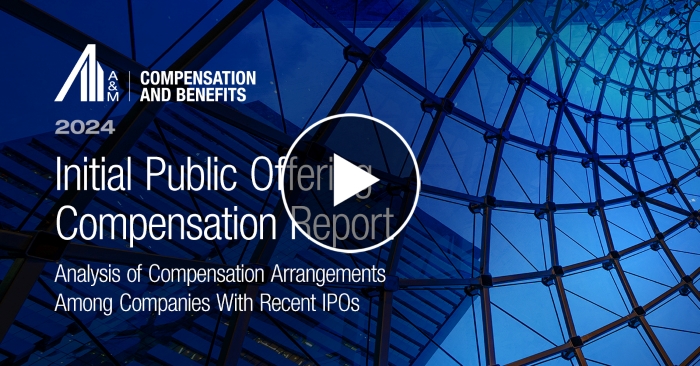2024 Initial Public Offering (IPO) Compensation Report
Alvarez & Marsal is proud to release the 2024 Initial Public Offering (IPO) Compensation Report. This report draws on data from proxy statements of 497 companies with a median market capitalization of approximately $731.2 million that have undergone IPOs in the past two years.
Effective compensation programs are critical to attract, retain and drive the performance of executives. Companies should ensure that their executive compensation programs are competitive with their market for talent throughout each phase of the company’s lifecycle, including leading up to and after an initial public offering (IPO).
Please click below to explore the findings of the 2024 Initial Public Offering (IPO) Compensation Report and download the full report:

Key findings include:
Total Compensation, Pre-IPO
- The median Chief Executive Officer (CEO) total compensation is approximately $800,000, while the 25th percentile is approximately $500,000 and the 75th percentile is approximately $1.5 million. The average CEO total compensation is approximately $2.6 million.
- The median Chief Financial Officer (CFO) total compensation is approximately $585,000, while the 25th percentile is approximately $415,000 and the 75th percentile is approximately $1.15 million. The overall average CFO total compensation is approximately $1.2 million.
- The median total compensation for all other Named Executive Officers excluding the CEOs and CFOs (herein referred to as NEOs) is approximately $575,000 while the 25th percentile is approximately $415,000 and the 75th percentile is approximately $980,000. The overall average NEO total compensation is approximately $1.35 million.
- Note, due to several extreme outliers, the average compensation data point throughout this report often ends up being higher than the 75th percentile.
Annual and Long-Term Incentive Compensation
- At the median, incentive compensation — including annual and long-term incentives — comprises approximately 80 percent of a CEO’s, 71 percent of a CFO’s, and 70 percent of an NEO’s total compensation package.
- Only 28 percent of companies utilize STI plans where payout is determined on a purely formulaic basis with no board discretion, while approximately 70 percent of companies utilize a program that is at least in part discretionary. The remaining 2 percent did not disclose what basis was used.
- Earnings are the most prevalent performance metric in STI plans and are utilized by 78 percent of companies. The
next most prevalent performance metrics are income/revenue measures (61 percent). - For LTI programs, using a single award vehicle was the most prevalent approach (67 percent of companies), followed by 27 percent of companies that utilize two vehicles for their LTI program.
- Time-vesting “appreciation-only” awards are the most prevalent LTI award vehicle, utilized by 80 percent of companies, with 52 percent of companies utilizing time-vested “full-value” awards, and 6 percent of companies utilizing performance-vested awards. The predominance of using appreciation-only awards among IPO companies differs significantly from the practices of more mature, non-IPO companies where full-value awards are much more prevalent.
- For time-based LTI awards, the most prevalent vesting period length was 4 to 5 years, and the most prevalent vesting approach disclosed was graded (incremental) vesting.
- The most common performance period is more than 5 years, used in 31 percent of all performance awards, with the second most prevalent being 3 to 4 years, which is used in 27 percent of performance awards.
Share Pool Authorizations and NEO Grant Allocations
- Sixty-two percent of companies adopted an “evergreen” provision for the share pool authorization in their LTI plan. An evergreen provision is one in which the share pool is automatically replenished (i.e., additional shares are added to the authorized pool) at regular intervals. The most prevalent evergreen percent is between 4 and 5 percent of fully diluted shares outstanding.
- For new share pool authorizations, the most prevalent number of shares authorized is between 6 and 9 percent of the fully-diluted shares outstanding. Because incentive compensation is such an integral part of the total compensation package for executives at most companies, we examine annual and long-term incentive programs in greater detail later in this report.







